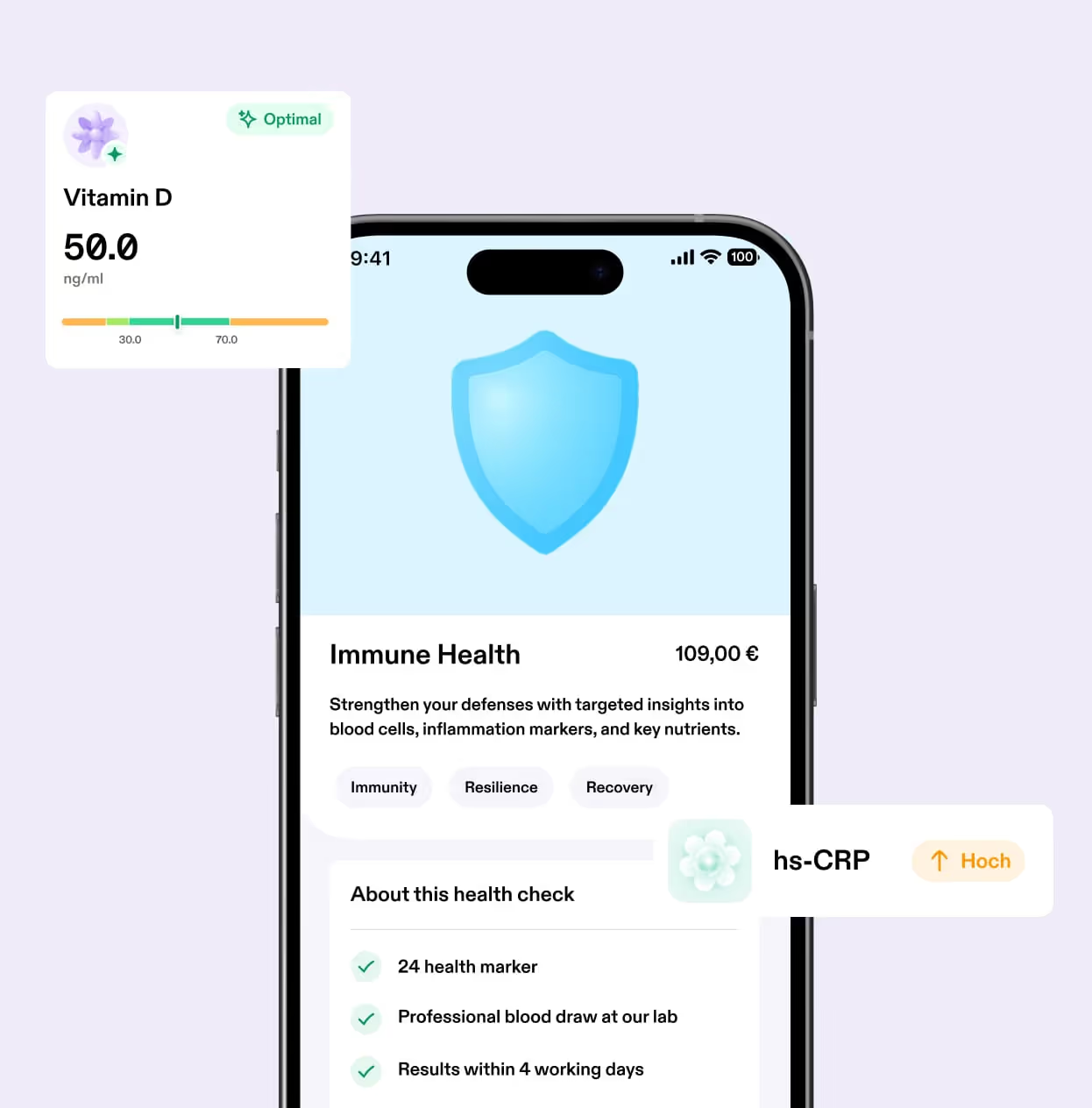Updated on
November 14, 2025
Can cold therapy boost your immunity?
Here’s what science says about the health effects of cold therapy.

Key Takeaways:
- Cold therapy has gained popularity in recent years with health influencers like Wim Hof promoting its benefits
- While research is still limited, some evidence suggests cold therapy may reduce inflammation, improve immune response, and help muscles recover after exercise
- Cold showers are the easiest and safest way to partake in cold therapy, though there are several other methods used
As we head into the winter months, taking a cold shower to improve our immune system may seem counterintuitive. Afterall, nothing feels better than a hot, steamy shower after commuting home in frigid temperatures. But there’s a school of thought that claims taking part in so-called cold therapy, including cold showers, comes with a number of health benefits.
You might be familiar with the concept of cold therapy, recently made popular in the mainstream by Wim Hof, a Dutch extreme athlete and world record holder who promotes its health benefits. Also known as “The Iceman,” he created the Wim Hof Method, which he says improves health by focusing on breathing, cold therapy, and a commitment to the practice.
Advocates of cold therapy like Hof claim it comes with a host of benefits, including reduced inflammation, improved immune response, a faster metabolism, and quicker recovery after exercise. But do these claims hold any water? Read on to learn what scientific research says about the effects of cold therapy on health.
What is cold therapy?
First, let’s talk about what cold therapy actually is. It’s defined as the practice of using cold water or ice to improve physical or mental health. There are many forms of cold therapy, which also goes by the names cold hydrotherapy and cryotherapy, but the most basic type is taking a cold shower. Other examples of cold therapy include ice baths, cold water swims, using ice packs, and cold water immersion therapy.
Can cold therapy boost immunity and lower inflammation?
Advocates of cold therapy claim the practice comes with a number of health benefits for both the body and mind. Here’s a closer look at what the science says regarding inflammation and the immune system.
Inflammation
Some research suggests cold therapy can reduce biomarkers associated with inflammation. Biomarkers refer to a broad category of medical signs that help doctors better understand a patient’s health. They are usually molecules found in the blood, bodily fluids, or tissues that can be measured and indicate a normal or abnormal process, or a medical condition or disease. A number of biomarkers are used to measure inflammation.
One study published in the journal Reumatologia looked at the effect of cold therapy on inflammation measuring biomarkers including C-reactive protein (CRP), a protein made in the liver in response to inflammation. While elevated CRP levels may be a sign of an acute or chronic infection or inflammation, persistently high levels can indicate a chronic condition like inflammatory bowel disease or rheumatoid arthritis. The researchers found that after being exposed to cold therapy, people with rheumatoid arthritis had a significant decrease in CRP levels compared to others with the condition who were treated with standard rehabilitation therapy.
Another study, published in PLOS One, determined that male athletes who participated in cold therapy after exercise had decreased levels of interleukin 1 beta (IL-1β), another biomarker associated with inflammation.
Improved immune function
Going back to the idea that a cold shower can help boost immunity, some research supports that practice. One study found that cold water swimming can lead to an increased level of white blood cells, which help the body fight off infections.
These findings support other research published in PLOS One that found people who took cold showers (for 30 to 90 seconds) for 30 consecutive days were 29 percent less likely to call out sick from work over the next three months compared to people who took warm showers. However, while individuals who took cold showers were less likely to be absent from work, they did not report fewer days of being sick. The researchers concluded that cold showers may therefore be tied to less severe symptoms of illnesses rather than the prevention of illnesses themselves.

What research says about other benefits of cold therapy, cold showers, and cold water immersion
Cold therapy is also said to improve vagus nerve activity, speed up metabolism, and lead to better recovery after exercise. Here’s a look at what the research says about these claims.
Improves vagus nerve activity
The vagus nerve is the longest cranial nerve in the body, spanning from the brain to the large intestine. It is responsible for involuntary bodily functions (meaning ones you can’t control), including digestion, heart rate, and the immune system.
Some research suggests cold therapy may stimulate the vagus nerve and reduce stress on the body by slowing down heart rate.
Speeds up metabolic rate
While many health influencers promote cold exposure as a means to lose weight, there is no robust scientific evidence that backs up these claims. However, some studies suggest cold therapy can increase your metabolic rate (the rate at which the body burns calories).
For years, researchers studied haenyeos, or female divers in Korea who earned their living harvesting seafood in very cold waters off Jeju island. Before the 1980’s when wetsuits were introduced, these women would endure the cold water while wearing only a thin cotton bathing suit. Researchers observing the haenyeos during this time found that their metabolic rate was significantly higher in winter diving months than summer diving months.
Better exercise recovery
You may have seen elite athletes wrap their limbs with bags of ice following intense training sessions to soothe their tired muscles. Science backs up that practice, although the results are somewhat inconclusive.
One study determined that cyclists who immersed themselves in cold water for 10 minutes following a one-hour intense training session had decreased leg soreness.
A research review of randomized controlled trials involving nearly 1,100 participants determined that cold therapy within an hour after exercise may reduce pain from delayed onset muscle soreness (DOMS) for 24 hours. However, the authors note that more high quality research is needed to determine the true benefits.

Immune Health Package
Strengthen your defenses with targeted insights into blood cells, inflammation markers, and key nutrients.

Package
Tips on how to get into cold therapy
One of the easiest ways to practice cold therapy is with cold showers. And while you certainly can jump straight into a stream of frigid water, it’s not necessary to reap the benefits. The study that found taking cold showers led people to take fewer sick days from work saw this benefit with warm-to-cold showers. Participants started showering with water temperatures as warm as they liked for as long as they liked but ended with 30, 60, or 90 seconds of the coldest temperature of water available. All of these times were tied to fewer sick days from work, suggesting your cold shower does not have to be very long at all.
Outside of cold showers, if you want to try other forms of cold therapy, you may consider:
- Ice baths Aim for two to 10 minutes, but do not stay in longer than 15 minutes
- Applying ice packs to sore or tired muscles for 15 to 20 minute intervals
- Swimming in cold water for short periods of time. Note that this should be done with caution, as it can lead to heart rhythm problems in people who are at risk
Tip: The best and easiest way to do cold showers is to start with your legs, then arms and work your way up to your upper body. Then rinse the rest of your body. If the cold is too much for you in the beginning, try taking a cold shower once or twice a week for a few seconds or minutes to build a tolerance.
Cold therapy isn't always a good idea. For some individuals, and certain health conditions like heart disease, or if you are pregnant, it may not be recommended or to be done with caution. You should consult your doctor first before starting a cold therapy routine.
Subscribe to our newsletter!
Articles, tips, and offers. Straight to your inbox.











